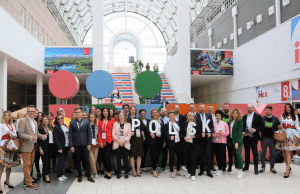In economics, assessments of individual achievements are only valid when set against other, comparable achievements. Two percent growth might be fantastic, for example, if everyone else is in the red. It is a huge failure, however, when others are recording three to five times that level of growth. The world’s largest trade shows, where the offer of an entire industry is on display under one roof, ruthlessly expose who is really who and how much they are worth on the global scale – be it a company or a country.
Our economy is not in the best of shape at the moment, as shown everyday by the latest bankruptcies, blocked bank accounts, laid-off workers or other similar occurrences. Added to that, the country is facing not only corruption, but also white collar crime, often under the patronage of politicians. Whilst some of us might feel quite at home in our cosy little nest, the largest global trade shows present an objective view of our industry in light of global competition. We certainly have companies here who are able to produce good products and confidently present themselves abroad. But that is it – more or less.
None of our industries are globally recognisable or make a substantial impact on the international market. This doesn’t mean we are not successful in exporting; rather, we just have to work much harder for profit than more established countries. We never seriously tried to shape and market the Made in Slovenia brand. Consequently, it doesn’t exist. And what doesn’t exist has no value. So when the press asks chancellor Merkel if Slovenia will truly follow Greece, buyers put even more pressure on prices and loans become a little more expensive.
Current exports still rely too heavily on exporters who foreign buyers can replace overnight, if not with better ones, certainly with cheaper ones. Trademarks able to deliver tangible added value are non-existent. Here and there we can find a notable exception, which can only have come about through overzealous media coverage. When everyone starts to copy them without a second thought, their directors end up becoming more media-present than silicone-filled reality show starlets.
Then there are other inappropriate messages contained within these stories. The first is that relatively small companies feature most prominently here, despite the fact that they employ only a handful of people and their contribution to the GDP is negligible. It’s as though big and successful systems are not important to the economy. The second, often false message is that success in business always depends on individuals. If that were true we could completely rule out the state. Only one outstanding student in a class where everyone else is barely making it is a sign there is a problem with the teacher, the school, or maybe the system itself – but not with the students.
This, among other factors, is the main weakness of our economy – we never built an environment providing the conditions for successful business development. Managers and engineers in successful countries are not that much more educated, hard working or capable than our own – the reason for differences could perhaps lie in added value per employee.
In short, forming a clear economic strategy (with the exception of projects like entry into EU and the Eurozone) was never undertaken in independent Slovenia. We know which issues were at the forefront of the political agenda in the last twenty years – they didn’t include economic success, to the extent that we still haven’t decided which industries are truly strategically important. We export our wood and we import furniture: at the same time our woodworking companies are melting away like snow in the spring sunshine. Officials turn up their noses at everything that doesn’t ring of oh-so-high technology, yet we are importing splinter wood from Austria for our stoves and fireplaces. And this is probably a by-product of the furniture made from exported Slovenian wood in the first place.
Even through the spectre of global trade shows, as a mirror on our economy, the now defunct magazine Gospodarski vestnik called attention to best practice examples of countries who lifted their national economy on to the international stage – for example, our neighbour Austria – and in the interim period very little to nothing happened. A year or so ago the Chamber of Commerce and Industry suddenly noticed the Austrian model of internationalization and started selling it as a recipe for success. We suffered a decade of delay before beginning to launch programmes such as ‘Go International’. For the Chamber to finally wake up, they first had to lose money. What had to happen was Prime Minister Janša taking away obligatory membership and achieving another result: cheap political points from those who never liked the Chamber in the first place. He removed a potentially dangerous centre of power, represented by managers who could possibly demand that the politicians finally address key questions, and in the end hammered the final nail into the programme’s coffin with changes in the leadership of the Chamber. And after all that’s happened, one year on and no one has asked the question of how the programme of internationalization would have come to life and survived without investment.
The point of this story is that today we have more and more countries with efficient internationalization programmes and they are developing or acquiring important competitive advantages (as do, for example, tax systems). A component of these programmes is, of course, good trade shows. Trade shows in Germany, the world’s leading expo country, attracted 2.55 million visitors from abroad last year, almost reaching its zenith of a 2008 record year, when they hit 2.6 million. Yet detailed analysis of statistic data clearly indicates that the international competitive struggle is getting increasingly more difficult – Germany will end 2011 with three or four percent more visitors and exhibitors and about one percent more exhibition space sold compared to the previous year.
The German tradeshow industry is developing new projects, builds modern exhibition halls or renews old ones, exports its exhibitions and knowledge all over the world and doesn’t leave a trail of unpaid suppliers behind. On the contrary, for every Euro dropping into the trade show cash register, the companies in the region make six to ten.
Andrej Prpič













